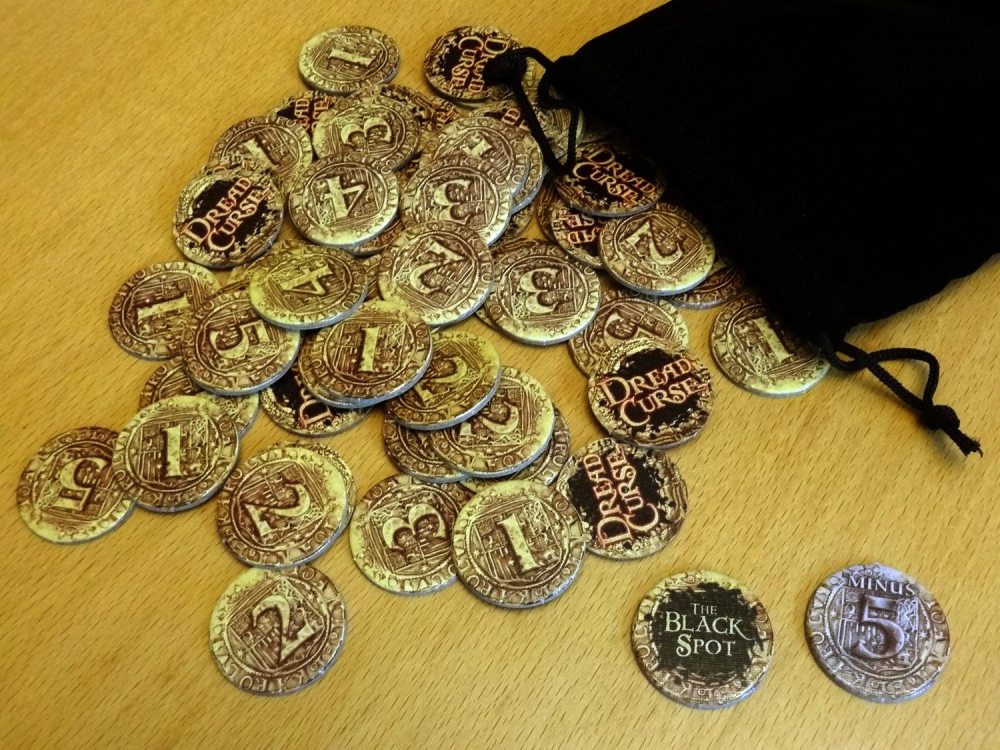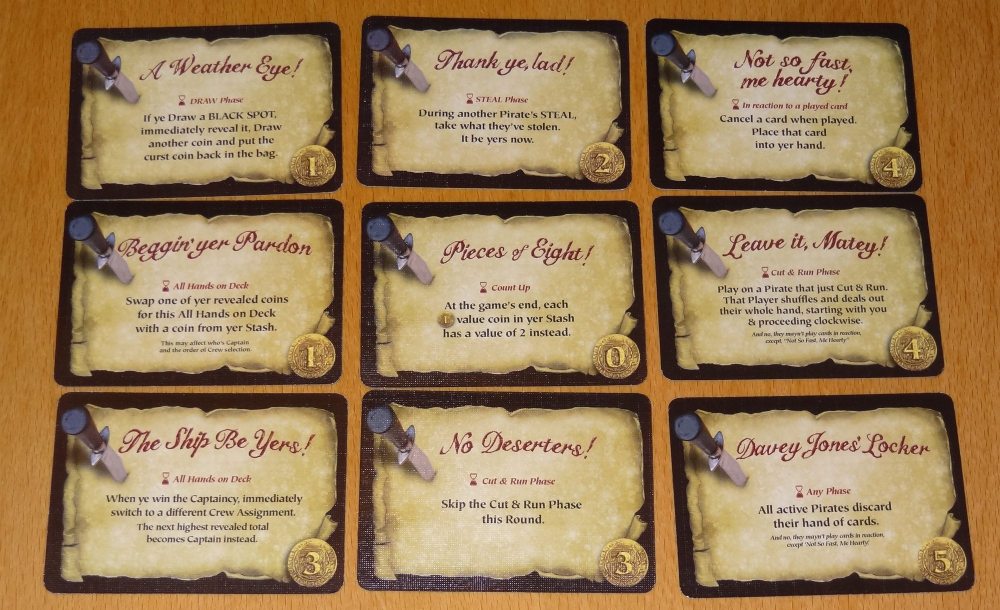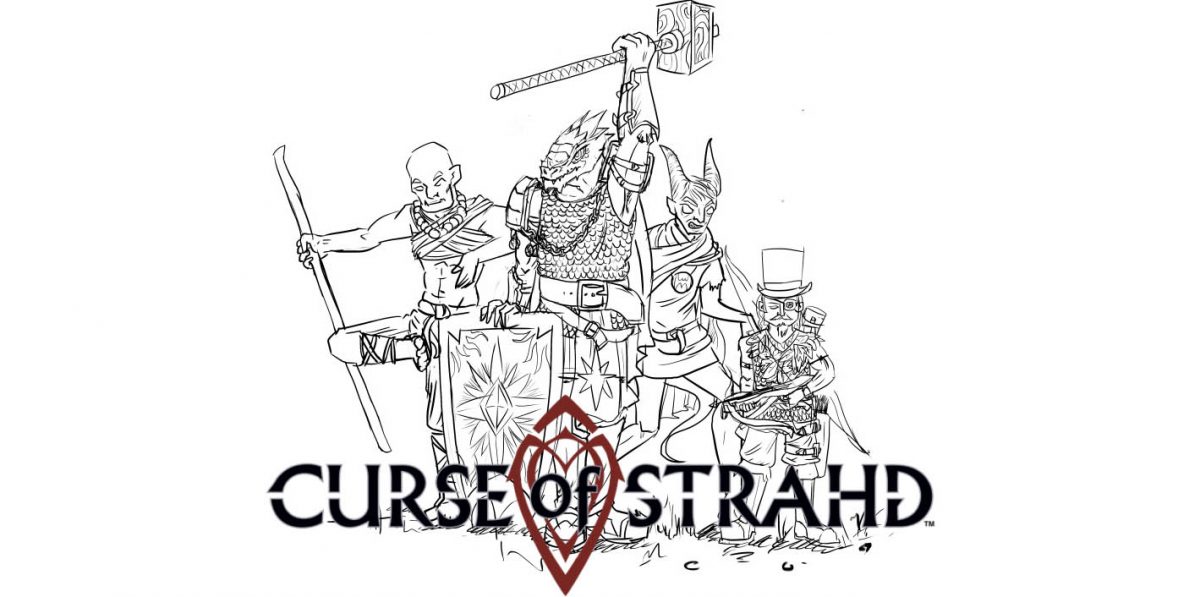
Yarr! Dread Curse be a game for dastardly pirates. Get loot, steal from those scurvy dogs and stab ’em in the back, but if ye get caught with the Black Spot, ye be doomed.
Ok, that’ll be all the pirate talk you get from me, I promise: but if you’re celebrating Talk Like a Pirate Day (September 19!) then this would be perfect for the occasion. Dread Curse, just released this year from Smirk & Dagger, is a pretty quick-playing game for 3 to 8 players who don’t mind a bit of spite with their fun. It retails for $30 and plays in 30-45 minutes.

Components
The game comes with 10 oversized cards: a turn summary, 8 pirate roles, and Jacques the cheeky monkey (of course). Each pirate role has a rank, a Draw, and a Cheat (the text in red) which gives them some special ability. There are also 54 Pirate’s Code cards that give you a leg up or let you mess with other players. And, of course, there’s a pile of gold coins in a velvet bag. (The velvet is real, the gold isn’t.) The coins are sturdy cardboard tokens—the backs are identical but they have different values, from 1 to 5. There are also two Black Spot coins and a Lead Slug which is worth negative five points.
The coins are nice and thick and punched out easily from the cardboard sheet, but I did notice one of my coins had some ink rubbed off on the back. At least it wasn’t either of the Black Spots or Lead Slug, but it does stick out when you’re looking at somebody’s stash. If you’re picky about box sizes, you should know that the box is larger than needed, but you can always stash everything except the rulebook into the black velvet bag for travel.

The artwork on the role cards is excellent, though you’ll notice that the Captain looks suspiciously like Hector Barbarossa from the Pirates of the Caribbean movie. That, and the female pilot looks like she forgot to button up her shirt—probably to distract you from the fact that she was pulling a gun on you. I do like that the role cards are oversized, too: it gives more room for the artwork and makes them easier to read from across the table when you’re making role selections.
How to Play
The object of the game is, as you might expect, to end up with the most gold at the end of the game—and none of the Black Spots. Because, after all, he who dies with the most gold … is still dead.
To set up the game, you mix one Black Spot with several other random coins (making sure the other Black Spot and Lead Slug aren’t included) and give one at random to each player. The player with the Black Spot is Captain for the first round, and all the other players get a role at random. It’s an interesting way to seed the game: first of all, one Black Spot is present from the start, and it makes sense thematically that the Captain is the one who is cursed.
All the rest of the coins are tossed into the bag and mixed up. Everyone gets three Pirate’s Code cards (or two in a 7 or 8 player game). Then the game begins. Each round includes these phases: Draw, Steal, Pay Jacques, Cut & Run, All Hands on Deck. The game goes until either only one active pirate remains or when the last coin is drawn from the bag.
Draw: In order of pirate rank, each player draws coins from the bag according to their role. For instance, the Captain can choose to draw between 2 and 4 coins; the Bosun always draws 2; the Cabin Boy doesn’t get one from the bag but gets to take one from the Captain instead.
Steal: After everyone has drawn, then (in order) each pirate gets to steal a coin. You can steal from the players next to you or the Captain, and several of the pirate cheats affect the Steal phase. For example, the Cabin Boy can’t be stolen from, and the First Mate can give away a coin instead of stealing one (a nice way to pass off a Lead Slug, for instance).
Pay Jacques: Once the stealing is over, everyone has an opportunity to get more Pirate’s Code cards by giving a single coin to the monkey. The coin has to be worth at least 2, and the monkey doesn’t make change. The only way to get cards is either by buying them from Jacques or using the Bosun’s power, which lets you take a card instead of stealing a coin.
Cut & Run: Here’s where you try to make your getaway. Everyone simultaneously reveals a coin from their stash: if it’s face-down, you’re sticking around for more loot. If it’s face-up, you’re counting up your haul and you’re out of the game, hopefully with more loot than anyone else will collect. One note: there are Pirate’s Code cards that let you swipe a coin from somebody who’s cutting and running, as well as cards that prevent everyone from leaving for a round.
All Hands on Deck: This is when the roles change hands. Everyone selects one or two coins from their stash and simultaneously reveals them. The player with the highest total is the next Captain, and then everyone else chooses roles in order of their bids. Ties are broken by revealing additional coins. While the revealed coins aren’t spent, it does mean that you’re showing people what you have in your stash, and if you bid high to become Captain there’s a good chance that people will try to steal from you in the next round.
If at any point there’s only one active pirate left after Cut & Run, or if the last coin is drawn from the bag, the game ends immediately. Any players with Black Spots automatically lose; everyone else counts up their gold and highest total wins. Pirate’s Code cards that haven’t been played are also worth between 1 and 5 gold.

Pirate’s Code cards are where the backstabbing really comes in. Each card states the phase in which it can be played (some can be played at any time) and will help you or harm your opponents. They’ll let you draw or steal extra coins, skip phases of turns, protect you from cards, and more. Plus, with their gold value, it doesn’t hurt to have a bunch in your hand … until somebody plays a card that lets them plunder your hand.
The Verdict
I first heard about Dread Curse at PAX East, when Curt Covert of Smirk & Dagger had an early mock-up of the game and explained how it would work, but I didn’t get to play it until its release at Gen Con. It ended up being one of my favorite games of the weekend, and one I expect I’ll be getting out often.
When I first saw Dread Curse, it reminded me a bit of Scallywags, another piratical game with a pile of coins. However, there are a few differences that give Dread Curse a bit more strategic depth—but it also makes the game a little longer and probably not best for younger kids. The role selections and abilities let you get rid of unwanted coins—plus all of the coins are unknown except for the Captain’s Black Spot at the very beginning of the game, so there’s always a chance to pawn off the curse on somebody else until the end. The variety of Pirate’s Code cards also make a difference, as you won’t be stuck with an entire hand of the same card—plus, they’re worth gold if you can’t play them, which is nice.
Even so, the game plays fairly quickly even with a large crowd, as long as people don’t spend too long agonizing over which role to take or who to steal from. The “Cut & Run” phase adds that press-your-luck element, particularly toward the end of the game when sticking around means somebody will probably try to give you a curse or a Lead Slug. However, that same mechanic means that there will be some players who might cut out early and then have to just sit and watch until the game ends: it only takes you so long to count up your gold.
I’ve played a few times (at Gen Con and back home) and I’ve had some really great moments while playing the game. In the last game I played, the Black Spot changed hands several times. At one point I got the First Mate so I could give it away, but the Mutiny card upgraded me to Captain instead. Then I’d finally gotten the Black Spot back into the bag and was planning to cut and run, when another player stopped me by playing the No Deserters! card. I figured I could end the game by running out the bag of coins—but then my Draw phase was canceled. The dust finally settled and one player ended up with both Black Spots and the Lead Slug. Serves him right, trying to steal my loot!
Curt Covert calls Dread Curse a good beer and pretzels sort of game: it’s not a deep strategy game but it’s a riot, and you can still have a conversation while you’re playing. That said, if you like backstabbing and greed (as well as the sometimes unfortunate consequences of being too greedy), then Dread Curse will make a fantastic addition to your game library.
Disclosure: GeekDad received a review copy of Dread Curse.




This sounds awfully similar to Libertalia, a masterpeice fo pirate gaming (and the box artwork bears more than a passing resemblence to the box art of the wonderful Merchants and Marauders).
Designers maybe taking the pirate theme to heart?
I haven’t played Libertalia but what I’ve heard from people who have played both is that aside from theme and having roles with abilities, the two are very different to play. Libertalia is a bit heavier strategy, Dread Curse is a bit more casual and faster.